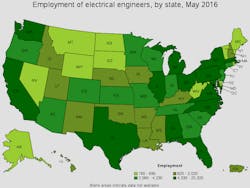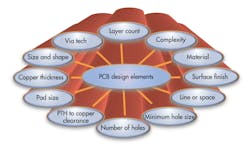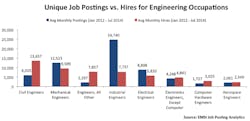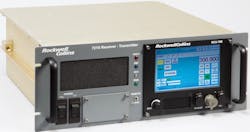During our 2016 Annual Salary & Career Report, one of the topics Electronic Design surveyed EEs about was what their biggest concerns were as an engineer. Those topics run the gamut from education and human resources issues to issues around pricing and products. Here’s Electronic Design’s list of top concerns among EEs. Also, be sure to check out our 2017 Salary & Career Report, due out this fall.
10. Outsourcing Issues
Issues around outsourcing are nothing new to the electrical and electronics engineering community and it seems as though outsourcing is here to stay. A series of questions arise when the EE considers this reality; luckily Electronic Design has had you covered on outsourcing issues for years, whether it’s avoiding pitfalls in outsourcing your project, picking the right partner for outsourcing manufacturing, establishing strong relationships with those you outsource to, or the simple question of whether or not to outsource at all.
9. Concerns about Job Security
8. Dealing with Reductions in Staff
Unfortunately for EEs and according to the Bureau of Labor Statistics, increases in the inventory of available jobs within the US Labor Market for them is not expected to rise over the coming few years. This is counter to the growth expected in other engineering fields, such as mechanical engineering. Want to keep your EE career on track with a contracting job market? According to the BLS, the strongest growth will be concentrated in heavy construction, satellite communications technologies, infrastructure, and business support services.
7. Age Discrimination
From Sam Davis, Editor at Power Electronics:
“A 2013 report by Aberdeen Group asserts that there will be a limited number of engineers and additional challenges faced by manufacturers. As the supply of engineers goes down, the price it takes to attract this talent will increase: “This causes trouble for many companies; over half of those surveyed indicated a lack of willingness to pay enough for top talent. This means these companies will have to resort to hiring freshly graduated engineers. While it is true new graduates are cheaper to acquire, they are also unproven and may lack the experience or maturity to contribute immediately."
Check out the full article here.
6. Price/Performance Issues
When it comes to price and performance, almost nothing can more easily sink a project or product in development. First, the EE has to explore what his or her requirements are and the best way to approach those from a technological perspective. Then comes sourcing, pricing, and avoiding the pitfalls of unreliable—or worse—counterfeit products. It’s when the EE is trying to fuse these two considerations that they can run into problems. Let us help you through that process with these articles from Electronic Design and sister brand Microwaves & RF:
"Get the Most Scope for Your Dollar"
"6 Effective Ways to Cut PCB Assembly Cost Without Sacrificing Quality"
5. Concerns about the General Health of the Economy
According to EMSI, an economic modeling firm, job postings relative to the number of applicants has worked in the favor of electrical engineers and against electronics engineers (excepting computer engineers) over the past few years. With 5,820 average monthly hires from 2012-2014, the 8,898 job postings available per month at the same time means that not all the job postings were filled with candidates. The labor market for electronics engineers is much tighter.
4. Product Quality Issues
The rise of the threat of counterfeit components and parts has been an ongoing development for many years for EEs. Overcoming these threats can come down to personal and enterprise-level vigilance, with a little help from government standards and accountability. Rockwell Collins became the first company to achieve Counterfeit Avoidance Accreditation for its supply-chain management procedures. Is your firm doing everything it can in the supply chain to overcome the plague of counterfeits?
3. Product Reliability Issues
We’ve seen it in embedded technology, test and measurement technology and even in MEMS—product reliability issues are a constant concern of the design engineer. Part of the solution of to that problem is to keep abreast of the latest technological developments and techniques for ensuring reliability in your products as seen in such Electronic Design and Microwaves & RF articles as the following:
"How to Choose a Cooling Fan in Five Easy Steps"
"Can MEMS Deliver for 5G Mobile Networks?"
"Rust and SPARK: Software Reliability for Everyone"
http://www.electronicdesign.com/industrial/rust-and-spark-software-reliability-everyone
2. Looming Project Deadlines
Sometimes the best way to beat deadlines is to take the easy road when it comes to test. But how do you know when you can cut corners and be less in-depth in testing your products? Daniel Bogdanoff explored that topic earlier this year. That said, we all know that, as James Morra put it in his article exploring automated test equipment, “new chips designed for tiny connected sensors and autonomous cars also require rigorous testing to ensure reliability.” So, what’s an EE to do? Here is a good place to start.
1. Staying Current with New and Emerging Technologies
The biggest concern for EEs in the job market today? How to stay ahead of the curve with the fast-paced development of new and emerging technologies. With the advent of machine learning, artificial intelligence, new materials, augmented reality, and deep learning, we’ve entered a whole new world of production and innovation. Then there’s the IoT revolution, 3D printing, and industrial automation. It’s all enough to make your head spin. The good news: staying informed and educated will provide the EE with the knowledge base to view these new and emerging technologies as opportunities instead of anxieties. Check out these articles on the new and emerging technologies affecting the EE community today:
"Materials Lay Foundations for Next-Generation Circuits"
"Metamaterial Antenna Grasps at Lower Frequencies"
"Machine Learning Offers Helping Hand To Edit Chips"
"Factory Automation Banks on Wireless and AI Technology to Succeed"
"Driverless Cars: Can We Accurately Regulate an Emerging Technology?"








